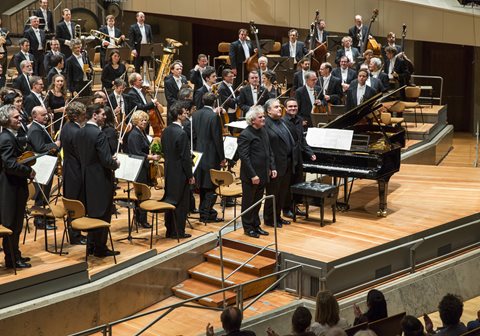
A VOICE OF DECONSTRUCTION
New Widmann Work at the S.F. Symphony
By Paul Hertelendy
artssf.com, the independent observer of San Francisco Bay Area music and dance
Week of June 25-July 3, 2016
Vol. 18, No. 74
First there was Superman. There was Batman. And now we have Widmann, flexing muscles reaching for super powers composing for orchestra.
Widmann’s 19-minute “Trauermarsch” shows off all the orchestra’s versatility and extremes. The highest notes, the lowest notes. The loudest sounds and the softest sounds, starting the mighty work with two wispy notes a half-tone apart, barely audible, repeated. Sounds ranging from the dreamy to the most rambunctious. Some consonances amidst the big dissonances, with seven percussionists unleashing their fortissimos like a raging hurricane.
And the Widmann opus heard June 23 challenged even the indominable veteran Yefim Bronfman, who nearly fell off the piano bench trying to play the Steinway’s most remote octaves.
I think Widmann and Bronfman both made their point. But the massive piles of sounds left the Davies Hall patrons muttering unhappily through the intermission, when all the doors were thrown open, presumably to air out all that accumulated sound warring within itself. And though this was the US premiere of the opus, one wondered about the SFS’ quandary, being the co-commissioner of the work, facing a near-mandatory scheduling of a thorny, unrewarding piece. The vaunted S.F. Symphony musicians surely merited better.
Jörg Widmann is a 43-year-old Munich composer. His orchestra in full cry is vehement indeed, propelled by the ultra-large percussion section and much brass, plus various special effects: deep-throated gurgles on trombones, salon keyboard music, crotales, gongs, waterphone, paired harps and tolling bells. Why he called it “Trauermarsch” is a mystery, as neither the rhythms nor the modality suggested anything approaching a funeral march. He had decontructed it beyond any vestige of recognition.
The rest of the SFS program offered no headlines, just predictable panache and high competence. MTT exhumed a symphony by Bach’s son Karl (known also as CPE), arranging animated interplay between the violins and the low strings, beautifully rendered. He also made audible CPE’s influence on the late Haydn symphonies composed 15-20 years later. This one is in D major, Helm catalogue No. 663, and warrants attention in avoiding the most familiar characteristic facets of CPE’s style (like dotted rhythms and high-leaping violin lines).
The Brahms First Symphony in C Minor offered revelations, particularly via the last movement’s glorious sunshine-coming-through the C-Minor clouds via the horn solo’s falling major-key solo (magnificently rendered by Robert Ward, then echoed by flutist Timothy Day).
While so many comment on the finale’s joyous march theme resembling Beethoven’s “Ode to Joy” theme, few notice the DihDihDihDAH patterns in the opening, recalling the intro to Beethoven’s Fifth Symphony. Brahms was paying homage to the German forerunner, either consciously or unconsciously.
San Francisco Symphony in concert June 23, Michael Tilson Thomas conducting; through June 25. For info: (415) 864-6000, or go online.
©Paul Hertelendy 2016
#
Paul Hertelendy has been covering the dance and modern-music scene in the San Francisco Bay Area with relish — and a certain amount of salsa — for years.
These critiques appearing weekly (or sometimes semi-weekly, but never weakly) will focus on dance and new musical creativity in performance, with forays into books (by authors of the region), theater and recordings by local artists as well.
#